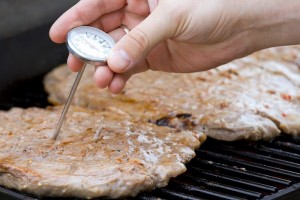Food Poisoning: Your Guide to Prevention
Every year, millions of people experience symptoms related to food poisoning. Typically, symptoms are mild; however, in some instances, they can escalate and lead to complications such as paralysis, kidney failure, and even death.
During a bout of food poisoning, it’s important to stay hydrated, get plenty of rest and see your physician if symptoms escalate.
With symptoms ranging from mild to severe, it’s often difficult to recognize the signs: how can you know for sure if your illness is just a minor digestive issue or a case of food poisoning? Jennifer Caudle, DO, an osteopathic family physician from Philadelphia, discusses the signs of food poisoning and provides food safety tips to keep you healthy.
Doctors of Osteopathic Medicine, or DOs, look beyond your symptoms to understand how lifestyle and environmental factors affect your wellbeing. They listen and partner with you to help you get healthy and stay well. They also encourage your body’s natural tendency toward self-healing.
Signs and Symptoms
Are signs of food poisoning immediate?
“Not always,” says Dr. Caudle. “Symptoms may start anywhere from a few hours or days after eating foods contaminated with harmful bacteria, such as salmonella, which is found in contaminated raw meat, eggs or dairy products,” she continues.
While symptoms vary due to the type of bacterial contamination, according to Dr. Caudle, sufferers can expect to experience one or more common symptoms like nausea, vomiting, diarrhea, fever, and abdominal pain and cramps. While most symptoms are mild and can be treated at home, Dr. Caudle recommends seeking medical attention if you begin experiencing these severe symptoms:
- Vomiting or vomiting blood that lasts more than a day
- Severe diarrhea for more than two days or blood in bowel movements
- Severe abdominal cramping
- Temperature higher than 101.5 F
- Dehydration signaled by excessive thirst, dry mouth, little or no urination, severe weakness, dizziness or lightheadedness
- Difficulty speaking
- Trouble swallowing
- Double vision
- Muscle weakness that progresses downward
Food poisoning symptoms often begin to improve on their own within 48 hours. Dr. Caudle recommends visiting your physician for treatment if your symptoms linger or escalate. She also stresses paying close attention to high-risk groups such as infants, older adults, and people with suppressed immune systems for signs of severe dehydration, as they may need to be hospitalized in order to receive intravenous fluids.
Steps to a Smooth Recovery
Food poisoning symptoms can be unbearable. However, there are a few things that you can do to improve your comfort level and prevent dehydration while you recover. Dr. Caudle recommends:
- Sucking on ice chips, taking small frequent sips of water, or drinking clear soda or broths. Drinking plenty of fluids is important to avoid dehydration.
- Easing back into eating by gradually adding bland, easy-to-digest foods like soda crackers, toast, bananas, and rice into your diet.
- Avoiding certain foods and substances, such as dairy products, caffeine, alcohol, nicotine, and fatty or highly seasoned foods, until you feel better.
- Getting plenty of rest.
- Avoiding anti-diarrheal medications (unless prescribed by your physician). That’s because drugs intended to treat diarrhea may slow the elimination of bacteria or toxins from your system and may make your condition worse.
Tips to Prevent Food Contamination and Poisoning
While there is no guaranteed method to prevent food poisoning, there are a few key steps that you can take to reduce your risk. Dr. Caudle suggests that you:
- Wash your hands well and often with warm, soapy water before and after handling or preparing food.
- Use hot, soapy water to wash the utensils, cutting board and other surfaces you use.
- Keep raw meat, poultry, fish, and shellfish away from other foods in order to prevent cross-contamination.
- Immerse and rinse fruits, vegetables, and pre-packaged salad leaves before eating.
- Use a food thermometer to cook foods to a safe temperature.
- Refrigerate or freeze perishable foods within two hours of purchasing them.
- Thaw foods safely by defrosting them in the refrigerator, in the microwave using the “defrost” or “50% power” setting, or by running cold water over them. Avoid thawing food on the kitchen counter, as food left at room temperature too long may contain bacteria or toxins that can’t be destroyed by cooking.
Food for Thought
“Generally, implementing food safety guidelines and practicing safe hygiene and sound judgment about uncertain foods is the key to reducing your food poisoning risk and maintaining good health,” says Dr. Caudle. “If you aren’t sure if a food has been prepared, served or stored safely, discard it,” she advises. “Trust your instincts. If there is any type of doubt about your food, just throw it out.”
